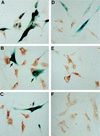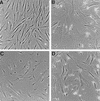Reinitiation of DNA synthesis and cell division in senescent human fibroblasts by microinjection of anti-p53 antibodies
- PMID: 9488478
- PMCID: PMC108876
- DOI: 10.1128/MCB.18.3.1611
Reinitiation of DNA synthesis and cell division in senescent human fibroblasts by microinjection of anti-p53 antibodies
Abstract
In human fibroblasts, growth arrest at the end of the normal proliferative life span (induction of senescence) is dependent on the activity of the tumor suppressor protein p53. In contrast, once senescence has been established, it is generally accepted that reinitiation of DNA synthesis requires loss of multiple suppressor pathways, for example, by expression of Simian virus 40 (SV40) large T antigen, and that even this will not induce complete cell cycle traverse. Here we have used microinjection of monoclonal antibodies to the N terminus of p53, PAb1801 and DO-1, to reinvestigate the effect of blocking p53 function in senescent human fibroblasts. Unexpectedly, we found that both antibodies induce senescent cells to reenter S phase almost as efficiently as SV40, accompanied by a reversion to the "young" morphology. Furthermore, this is followed by completion of the cell division cycle, as shown by the appearance of mitoses, and by a four- to fivefold increase in cell number 9 days after injection. Immunofluorescence analysis showed that expression of the p53-inducible cyclin/kinase inhibitor p21sdi1/WAF1 was greatly diminished by targeting p53 with either PAb1801 or DO-1 but remained high and, moreover, still p53 dependent in cells expressing SV40 T antigen. As previously observed for induction, the maintenance of fibroblast senescence therefore appears to be critically dependent on functional p53. We suggest that the previous failure to observe this by using SV40 T-antigen mutants to target p53 was most probably due to incomplete abrogation of p53 function.
Figures








Similar articles
-
Microinjection of anti-p21 antibodies induces senescent Hs68 human fibroblasts to synthesize DNA but not to divide.Cancer Res. 1999 Oct 15;59(20):5341-8. Cancer Res. 1999. PMID: 10537318
-
Mutant p53 can delay growth arrest and loss of CDK2 activity in senescing human fibroblasts without reducing p21(WAF1) expression.Exp Cell Res. 2003 May 1;285(2):236-42. doi: 10.1016/s0014-4827(03)00050-8. Exp Cell Res. 2003. PMID: 12706118
-
Telomere-based proliferative lifespan barriers in Werner-syndrome fibroblasts involve both p53-dependent and p53-independent mechanisms.J Cell Sci. 2003 Apr 1;116(Pt 7):1349-57. doi: 10.1242/jcs.00331. J Cell Sci. 2003. PMID: 12615976
-
SV40-mediated immortalization of human fibroblasts.Exp Gerontol. 1996 Jan-Apr;31(1-2):303-10. doi: 10.1016/0531-5565(95)00024-0. Exp Gerontol. 1996. PMID: 8706800 Review.
-
Genes involved in the control of cellular proliferative potential.Ann N Y Acad Sci. 1998 Nov 20;854:8-19. doi: 10.1111/j.1749-6632.1998.tb09887.x. Ann N Y Acad Sci. 1998. PMID: 9928415 Review.
Cited by
-
Down-regulation of wild-type p53-induced phosphatase 1 (Wip1) plays a critical role in regulating several p53-dependent functions in premature senescent tumor cells.J Biol Chem. 2013 Jun 7;288(23):16212-16224. doi: 10.1074/jbc.M112.435149. Epub 2013 Apr 23. J Biol Chem. 2013. PMID: 23612976 Free PMC article.
-
Senescent cells: A therapeutic target for osteoporosis.Cell Prolif. 2022 Dec;55(12):e13323. doi: 10.1111/cpr.13323. Epub 2022 Aug 19. Cell Prolif. 2022. PMID: 35986568 Free PMC article. Review.
-
Induction of p53-dependent p21 limits proliferative activity of rat hepatocytes in the presence of hepatocyte growth factor.PLoS One. 2013 Nov 4;8(11):e78346. doi: 10.1371/journal.pone.0078346. eCollection 2013. PLoS One. 2013. PMID: 24223793 Free PMC article.
-
Interaction of p53 with the Δ133p53α and Δ160p53α isoforms regulates p53 conformation and transcriptional activity.Cell Death Dis. 2024 Nov 19;15(11):845. doi: 10.1038/s41419-024-07213-4. Cell Death Dis. 2024. PMID: 39562560 Free PMC article.
-
Role of p14(ARF) in replicative and induced senescence of human fibroblasts.Mol Cell Biol. 2001 Oct;21(20):6748-57. doi: 10.1128/MCB.21.20.6748-6757.2001. Mol Cell Biol. 2001. PMID: 11564860 Free PMC article.
References
-
- Abarzua P, LoSardo J E, Gubler M L, Neri A. Microinjection of monoclonal antibody PAb421 into human SW480 colorectal carcinoma cells restores the transcription activation function to mutant p53. Cancer Res. 1995;55:3490–3494. - PubMed
-
- Bacchetti S. Telomere dynamics and telomerase activity in cell senescence and cancer. Cell Dev Biol. 1996;7:31–39.
-
- Banks L, Matlashewski G, Crawford L. Isolation of human p53 specific monoclonal antibodies and their use in the study of human p53 expression. Eur J Biochem. 1986;159:529–534. - PubMed
Publication types
MeSH terms
Substances
LinkOut - more resources
Full Text Sources
Other Literature Sources
Research Materials
Miscellaneous
